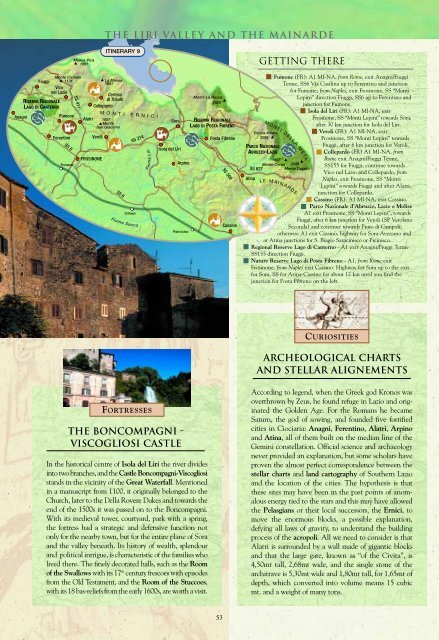Walking through time Walking through time - IBAM
Walking through time Walking through time - IBAM
Walking through time Walking through time - IBAM
You also want an ePaper? Increase the reach of your titles
YUMPU automatically turns print PDFs into web optimized ePapers that Google loves.
the liri valley and the mainarde<br />
Monna Pica<br />
1061<br />
ITINERARY 9<br />
getting there<br />
Monte Civitella<br />
Fiuggi 1131<br />
La Monna<br />
1951<br />
Vico<br />
nel Lazio<br />
Certosa<br />
RISERVA REGIONALE<br />
di Trisulti<br />
LAGO DI CANTERNO<br />
Collepardo<br />
Anagni<br />
Fumone<br />
Alatri 1057<br />
Monte<br />
San Giacomo<br />
Ferentino<br />
SS 6<br />
FROSINONE<br />
SS 411<br />
Veroli<br />
FROSINONE<br />
M O N T I E R N I C I<br />
SS 6<br />
Fiume<br />
CEPRANO<br />
Sacco<br />
SS 214<br />
Liri<br />
Fiume<br />
Sora<br />
Isola del Liri<br />
Arpino<br />
PONTECORVO<br />
Monte La Rocca<br />
1925<br />
RISERVA REGIONALE<br />
LAGO DI POSTA FIBRENO<br />
Posta Fibreno<br />
SS 509<br />
Cassino<br />
PARCO NAZIONALE<br />
ABRUZZO-LAZIO<br />
Atina<br />
Rocca Altiera<br />
2085<br />
SS 627<br />
1657<br />
Monte Corno<br />
L E<br />
M O N T I<br />
Fumone (FR): A1 MI-NA, from Rome, exit Anagni/Fiuggi<br />
Terme, SS6 Via Casilina up to Ferentino and junction<br />
for Fumone; from Naples, exit Frosinone, SS “Monti<br />
Lepini” direction Fiuggi, SS6 up to Ferentino and<br />
junction for Fumone.<br />
Isola del Liri (FR): A1 MI-NA, exit<br />
Frosinone, SS “Monti Lepini” towards Sora,<br />
after 30 km junction for Isola del Liri.<br />
Veroli (FR): A1 MI-NA, exit<br />
Frosinone, SS “Monti Lepini” towards<br />
Fiuggi, after 6 km junction for Veroli.<br />
Collepardo (FR) A1 MI-NA, from<br />
Rome exit Anagni/Fiuggi Terme,<br />
2039 SS155 for Fiuggi, continue towards<br />
Monte Cavallo<br />
Vico nel Lazio and Collepardo, from<br />
Naples, exit Frosinone, SS “Monti<br />
Lepini” towards Fiuggi and after Alatri,<br />
junction for Collepardo.<br />
Cassino (FR): A1 MI-NA, exit Cassino.<br />
Parco Nazionale d’Abruzzo, Lazio e Molise<br />
A1 exit Frosinone, SS “Monti Lepini”, towards<br />
D E L L A<br />
M A I N A R D E<br />
M E TA<br />
Fiuggi, after 6 km junction for Veroli (SP Verolana<br />
Seconda) and continue towards Prato di Campoli;<br />
otherwise A1 exit Cassino, highway for Sora-Avezzano and<br />
at Atina junctions for S. Biagio Saracinisco or Picinisco.<br />
Regional Reserve Lago di Canterno - A1 exit Anagni/Fiuggi Terme<br />
SS155 direction Fiuggi.<br />
Nature Reserve Lago di Posta Fibreno - A1, from Rome exit<br />
Frosinone, from Naples exit Cassino. Highway for Sora up to the exit<br />
for Sora, SS for Atina-Cassino for about 12 km until you find the<br />
junction for Posta Fibreno on the left.<br />
CURIOSITIES<br />
ARCHEOLOGICAL CHARTS<br />
AND STELLAR ALIGNEMENTS<br />
FORTRESSES<br />
the Boncompagni -<br />
Viscogliosi castle<br />
In the historical centre of Isola del Liri the river divides<br />
into two branches, and the Castle Boncompagni-Viscogliosi<br />
stands in the vicinity of the Great Waterfall. Mentioned<br />
in a manuscript from 1100, it originally belonged to the<br />
Church, later to the Della Rovere Dukes and towards the<br />
end of the 1500s it was passed on to the Boncompagni.<br />
With its medieval tower, courtyard, park with a spring,<br />
the fortress had a strategic and defensive function not<br />
only for the nearby town, but for the entire plane of Sora<br />
and the valley beneath. Its history of wealth, splendour<br />
and political intrigue, is characteristic of the families who<br />
lived there. The finely decorated halls, such as the Room<br />
of the Swallows with its 17 th century frescoes with episodes<br />
from the Old Testament, and the Room of the Stuccoes,<br />
with its 18 bas-reliefs from the early 1600s, are worth a visit.<br />
According to legend, when the Greek god Kronos was<br />
overthrown by Zeus, he found refuge in Lazio and originated<br />
the Golden Age. For the Romans he became<br />
Saturn, the god of sowing, and founded five fortified<br />
cities in Ciociaria: Anagni, Ferentino, Alatri, Arpino<br />
and Atina, all of them built on the median line of the<br />
Gemini constellation. Official science and archaeology<br />
never provided an explanation, but some scholars have<br />
proven the almost perfect correspondence between the<br />
stellar charts and land cartography of Southern Lazio<br />
and the location of the cities. The hypothesis is that<br />
these sites may have been in the past points of anomalous<br />
energy tied to the stars and this may have allowed<br />
the Pelasgians or their local successors, the Ernici, to<br />
move the enormous blocks, a possible explanation,<br />
defying all laws of gravity, to understand the building<br />
process of the acropoli. All we need to consider is that<br />
Alatri is surrounded by a wall made of gigantic blocks<br />
and that the large gate, known as “of the Civita”, is<br />
4,50mt tall, 2,68mt wide, and the single stone of the<br />
architrave is 5,30mt wide and 1,80mt tall, for 1,65mt of<br />
depth, which converted into volume means 15 cubic<br />
mt. and a weight of many tons.<br />
53
















